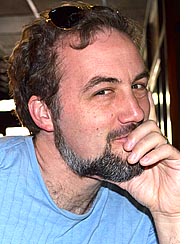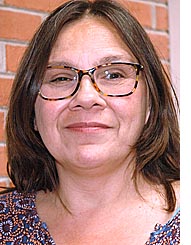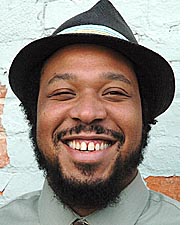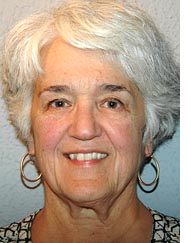Four villagers running for school board, two for re-election
- Published: October 5, 2017
Four candidates — two incumbents and two challengers — are running for three open seats on the Yellow Springs Board of Education in the Nov. 7 election.
Seeking re-election on the five-member board are Steve Conn and Aïda Merhemic. Also running are first-time office-seekers Dawn Johnson and Steve McQueen. Board member Anne Erickson, whose tenure concludes this year, chose not to seek another term.
In the weeks leading up to the fall election, the News is profiling candidates for local offices. This week’s paper focuses on the four school board hopefuls — in alphabetical order — who were asked to talk about why they are running, what experiences and skills they bring, what they consider to be the most pressing concerns for local schools and their thoughts on facilities needs being discussed by the district.
Steven Conn
As a member of the steering committee that drafted the school district’s 2020 strategic plan, which was adopted in 2011, Steven Conn said he ran for a seat on the Yellow Springs school board in the subsequent election cycle because he wanted to help implement the plan’s objectives.
“It was kind of a way of putting my money where my mouth is,” he said.
Now, after serving on the board for four years — in which time the district has acted on each of the plan’s six priorities, with the exception of addressing identified facilities needs — Conn said he is seeking a second term in part to finish the job.
“I want to see this through,” he said.
Additionally, he wants to challenge the board “to start talking about a new strategic plan.” He noted that if he is re-elected this fall, his new term would end in 2021. “I want to finish this [plan] out and initiate the next one.”
He said he is inspired to seek a second term not only because of the work he hopes to complete, but also because of his high opinion for those with whom he has served.
“I really have had a terrific time working with this board,” he said, citing their “talents and chemistry” as superior to other boards of which he has been a part in his 20-plus years working in higher education. “I’ve learned a tremendous amount from my fellow board members,” he said.
A professor of American history at Miami University, Conn moved to Yellow Springs with his family in 2004. Daughter Olivia Brintlinger-Conn graduated from the high school last spring, and son Zach is a senior this year.
“I have a professional and personal dedication to public education … not just for kids, but for communities,” Conn said.
He said that in addition to the experience he has acquired during his elected term and in his career as an educator, he is “pretty good at digesting” a variety of reports and information quickly, which often comes into play on the district board.
“I’m also a pretty strong writer,” he added. “I didn’t anticipate that when I first ran, but I’ve done quite a bit of writing and editing in my role on the school board.”
He also identified having “some skills around facilitation and consensus building,” pointing to his participation last year in contract negotiations with the Yellow Springs Education Association, the collective bargaining unit for district teachers.
He described the process as “nontraditional,” with “no lawyers.”
“I had a role in moving negotiations through to, I think, a pretty good outcome.”
Acknowledging that “a lot of people” may perceive the facilities issue as the most pressing for the district, “I have a different response to this,” Conn said.
“The consistent challenge we face is that the state has not been a reliable partner,” he said.
One issue is funding. “The [district] treasurer is required to have a five-year plan. Unanticipated changes in the state budget can play havoc with local finances, as do new legislative mandates that are made without additional funding for their implementation.”
He expressed frustration with “often unannounced” state mandates in such areas as testing and “the ever-shifting ground of graduation requirements.”
“Meshing these two things [funding and mandates] has been the most consistent challenge we have faced,” he said.
Not that the facilities issue isn’t pressing. The topic was put on the table in the strategic plan seven years ago because “our schools are not physically in good shape,” Conn said. “Some version of the status quo is neither feasible nor financially responsible.”
He compared the situation to a car that’s leaking oil. “Do you keep putting oil in? The status quo is continuing to pour oil into a leaking oil tank.”
He noted that the nearby Greenon school district recently passed a levy, after an initial rejection, for a $54 million K-12 campus. In the first week of school this year, at the high school that is now slated to be replaced, “a large piece of their ceiling collapsed,” he said.
“That’s what you’re up against in buildings that are 50-plus years old,” as are Yellow Springs buildings.
“Something has to be done,” he continued. “I can not see any way around doing work on the buildings.”
At the same time, he said he understands community concerns about cost. “We have to find the option that is financially viable for the community.”
“What the solution is, is still in the works,” he said, though he has gone on record as not supporting a proposed option to locate a K–12 campus at the current McKinney/YSHS site.
In the meantime, Conn said the continuing discussion is not helped by certain voices in the community that have been “downright nasty and rude.”
The most important thing to consider is “what’s best for kids in the district right now and for kids who come along 30 years from now.”
“There’s a drift of conversation that the village is somehow taxing itself to death,” Conn added. “But if we look at the numbers” comparing Yellow Springs to other area districts, “we’re not at the top of the charts. … We get a tremendous bang for the buck,” he said.
Dawn Johnson
With a background in city and regional planning, villager Dawn Johnson thinks her skills and experience would benefit the school board as well as the entire community, particularly at this time as the district considers pursuing costly major construction and/or renovation projects.
“I’m running because I want to serve my community, first off,” she said, “and I think that I can bring a lot of my [expertise] to the school board.”
She currently works as the Geographic Information System, or GIS, coordinator for Warren County. Her office develops comprehensive plans for area communities. “We do a lot of data analysis.”
Such planning involves “needs assessments and lots of face-to-face with the community,” she said. “We’re active listeners,” with the goal of developing a plan that “is reflective of what the community wants.”
She sees those strategies as clearly applicable to school district needs.
A village resident for 20 years, Johnson has been married to former school board member William Firestone since 2005. They each had two children from prior marriages, and all four young people went through Yellow Springs schools. She’s now a grandmother of three.
“I love children,” she said, and she has a deep respect for public education that goes back to her own childhood.
“My family comes from very humble roots,” Johnson said. Nevertheless, her grandfather graduated from high school at a time when others in similar circumstances often left school for work.
Now, as Johnson perceives public education being threatened at the national level, she said she is “grateful that this community supports education the way it has.” Her hope is that “we can be a beacon with our superior, excellent education.”
To do that will take some work, however. “The most pressing issue” Johnson sees “is the need to balance our obvious facility needs — our aging facilities — and the desire to keep the cultural diversity that Yellow Springs is known for.”
The challenge, she said, is figuring out how to fund building modernization without “driving young families out of town, or making it impossible for them to move to town, for that matter. … I don’t want our diversity to come strictly from open enrollment.”
She said she questions how much taxes can rise “without changing the [village’s] demographics.”
Ideas for moving forward can be found in the community, she said. “I think it’s important that the board doesn’t lead without learning where the community wants to go.”
She said that the community pulse meetings this summer were a “good start” in opening up the discussion about facility needs “to more voices,” but she is concerned that there hasn’t been enough public engagement.
She has looked through school board minutes from the past year and half and “saw only bits and pieces” of what is being considered.
“People really feel blind-sided by this,” she said of the proposals on the table and their costs. “I think I’m paying a lot of attention for what’s going on,” yet the process has not been as open as she feels it could or should be.
She said the district should have started the process by forming a “blue-ribbon panel” with members from various constituencies in the community. “I have never seen a plan accepted unless it came from the community,” Johnson said. “Top-down plans are usually controversies.”
She also thinks the district is moving too quickly. “I think they’re rushing the building discussion,” she said. “Slow down and trust the community.” For her part, she hopes the final decision saves “our Mills Lawn green space and its heritage trees.”
In addition to engaging in facilities planning, Johnson said she also wants to ensure that local teachers are well supported.
“I think funding and keeping good teachers will be our next hurdle.” She questions whether putting substantial financial resources into buildings will affect the district’s ability “to get the best teachers.”
“I would prioritize competitive salaries and benefits over spending for expensive new buildings,” she said.
Other areas of particular interest for Johnson include state testing requirements and funding for special needs students.
“I know Yellow Springs has pushed back [on testing], and I would like to get more involved in learning how other schools manage it. One-size-fits-all testing does not fit our children. I would continue to be an advocate against it.”
As for special needs students, “funding keeps going down or away and these children are not,” she said. “I’m concerned how we make a positive experience for those students.”
“I’d also like to know why so many Yellow Springs families send their children to private schools. What is it that motivated them [to leave]? Is there something we can do to bring them back?”
Steve McQueen
“We have some really big issues that we’re facing as a town,” particularly concerning equality, justice and tolerance, Steve McQueen said, and serving on the school board is the most effective way he sees that he can play a part in addressing them at a foundational and transformative level.
A member of the Human Relations Commission and the Justice Task Force, he also serves on the boards of YS Heritage and Home, Inc. and is active with The 365 Project and its affiliated Young People of Color, or YPOC, group. He is also a member of Central Chapel AME Church, where he is the church drummer.
McQueen said he is committed to helping the village live up to its highest ideals, and his civic activities bear witness to his interests and goals.
A native of New Jersey, McQueen came to town in 2003 to attend Antioch College, and except for some traveling, including a trip to Kenya in 2006, he “never really left,” he said.
Now his home life, just outside the village limits on Lamont Street, includes two children in the schools and a job as the radio reading services coordinator for Goodwill Enterprises. “We provide the news, books, magazines 24/7 for the blind, illiterate, autistic and others,” he said.
He said he has “major love for Yellow Springs.” But that love doesn’t obscure his vision of how things could improve.
When it comes to our schools, “some things do squeak by,” he said.
Instances of “intolerance” pertaining to “race and class” have surfaced in recent years, he said.
“Our kids are being bullied over racial issues, sexual orientation. … When students are saying it’s affecting them here, we must address that.”
The reports of bullying don’t fit how the village or school communities think of themselves, and they’re difficult to discuss, he said, but “this is where we are now.”
It’s important that “we are willing to face it, as opposed to fighting against” the reality, he said.
Through 365 and YPOC, he has been involved with some school programming to help address the issues, including an African-arts event last winter.
McQueen also wants to make certain that district teachers get the support they need.
“We have some great teachers here, and I want to maintain that,” he said. “I want to make sure to hear what the teachers say, that we listen to them. I want them to know we have their backs.”
As for the facilities issue, “clearly what we need to do when it comes to renovating or rebuilding, we’re at a crossroads or crunch time, where we know something has to be done,” he said. “The question is: how are we going to do it, and listen to everyone?”
McQueen said he wants to make certain that people whose voices might be missed, such as “fixed-income elderly who live nowhere near Mills Lawn,” are heard.
As he sees it, “the biggest problem we’re facing is trying to work together.”
“When it comes to facilities, there’s no one solution” and no way to make everyone happy, he said.
“What my father taught me — a preacher’s son — [when] not everyone is all pleased, at least [make it so] not everyone is all upset.”
The reality is that “not everybody‘s going to get what they want. We should already be starting the conversations — ‘If the thing I didn’t want happens, here’s how I would like to compensate for that.’ Whatever it is, let’s start talking about solutions.”
We also “have to make sure the kids and teachers are comfortable — and parents, too.”
The understanding the community needs to reach is whether “people are willing to work with the district whatever decision is made,” he said. “The more we can get everyone’s perspectives, and really face where we re now,” it’s all for the better, he said.
Aïda Merhemic
After serving 12 years on the school board, currently as board president, Aïda Merhemic said her commitment to local youth is unwavering.
“I want to empower youth, and I want to support them any way I can,” she said.
“I feel very honored to hold this position,” she said of her school board tenure, and she believes that her “historical perspective and experience” are valuable resources on the board.
As a longtime psychologist in town, in practice with her husband, Bob Barcus, at Yellow Springs Psychological Center, Merhemic said her skills include active listening, patience and mediation. She said she values strong relationships and tries to foster a collaborative style of working with her fellow board members, district administrators and staff, parents, students and community members.
“I tend toward process more than I do toward content,” she said.
She cited a variety of issues facing the school district and its students.
“State funding is always an issue,” she said, noting her desire to “establish a solid relationship with legislators.”
“Technology and the rapid change of technology,” are also important considerations for the board in ensuring that “our kids have what they need.”
Testing is another issue. For Merhemic, state-mandated testing is inadequate in assessing such essential outcomes as whether students are “critical thinkers” or effective at “problem-solving.”
“I see students as co-learners, co-creators and co-evaluators, and I think there are ways to assess all that besides tests,” she said. “Testing narrows our curriculum.”
More important than test results are “how students demonstrate their ability to think, how creative they are, how they present their work.”
“Not to say I don’t see testing as unvaluable,” she added, “but I don’t see that the kind of testing that we’ve been focusing on has been helpful.”
Five years into the initiation of the district’s Project-Based Learning curriculum, Merhemic wants to continue to support and improve the program, including seeing students take more of a lead in what she calls their “learning journey.”
“I think what we really want is learners excited about what they’re doing. That can really only come from them.”
Turning her attention to the facilities question, Merhemic began by saying that the school board’s job is: “to hire and fire the superintendent and treasurer and policy work.”
How that pertains to the facilities issue is that “Mario [Superintendent Basora] will bring a plan to the board as it gets clearer, and the board will decide if that moves on” to the voters in the form of a tax levy request, she said.
“Right now, we are engaged in an active listening process. … I appreciate hearing from everyone. And I am saying yet again, we have not made a decision.”
She said that while she is an advocate for children, she also feels “the whole lifespan is important” and is “sensitive to our elders and people on fixed income.”
“I don’t want to diminish or devalue that,” she added.
This is a very complicated process,” she said. For her part, she has been reading various studies and reports and has attended two related workshops.
Regarding the Ohio Facilities Construction Commission’s recommendation that Yellow Springs build new structures, she noted that people have said the state agency is biased toward new construction. “What they are for is making buildings that will last and have more integrity,” Merhemic said.
Merhemic also takes some issue with the call by some in the community to preserve the green space on the Mills Lawn property. “I value green space,” she said. “Many of us have been committed to fighting for that around us as well. Part of my homework has been wrapping myself around the traffic issue and seeing how much that space is being used. Honestly, I do not see a lot of people use that green space.”
From her perspective, the board is moving slowly, she said, and she welcomes the chance to gather more information through the community survey started this week.
At the same time, she said “everybody on the board feels particularly sensitive” to community criticisms they feel are unwarranted. “I just want to defend my board on some level,” she said.
“Like evolving brain research, where we’re learning more about how the brain works. I feel that’s true with the building process too,” she said.
“I am not into spending money needlessly,” she concluded. “That is just not my style. Period.”
Contact: csimmons@ysnews.com
The Yellow Springs News encourages respectful discussion of this article.
You must login to post a comment.
Don't have a login? Register for a free YSNews.com account.


















No comments yet for this article.